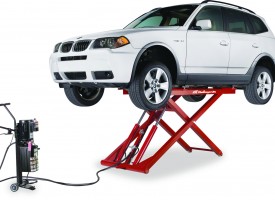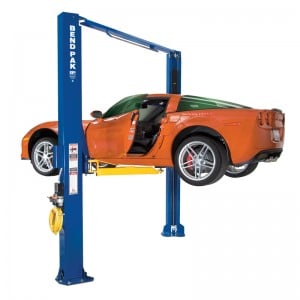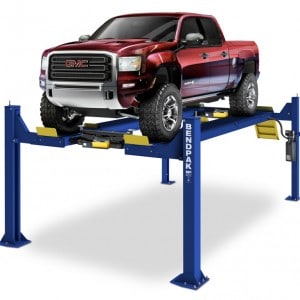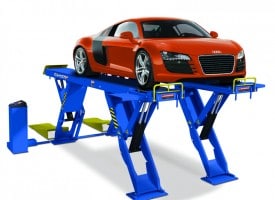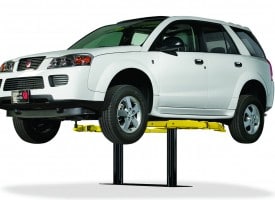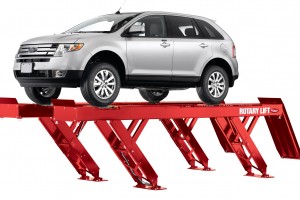Auto Lifts
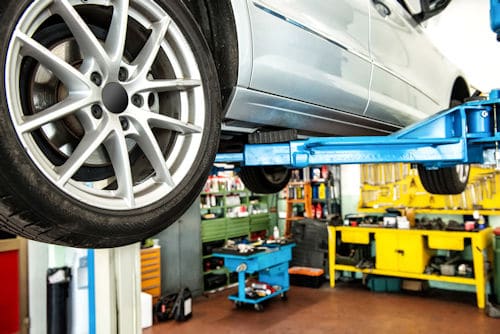
That is where we come in. We would like to help take some of the confusion out of lifting mechanisms and help you to decide which ones you really need. In this article, we will break down the main types of auto lifts for you, and describe the different mechanisms by which they lift. If you are an aspiring mechanic or like to work on cars at home, please check out our article on the best car lifts for home garages.
As you can probably tell from the name, auto lifts are used to raise automobiles off of the ground. Unlike bottle jacks and floor jacks that only raise a corner of a vehicle for changing a tire, an auto lift will raise an entire vehicle.
They can be used in professional garages, or at home. When considering a purchase of one of these lifts there are a few different types to consider:
Low/Mid Rise Frame Engaging: These are the most entry level lifts, often used for home garages, or auto enthusiasts. They often use either scissor lifts or parallelogram lifts, and are raised and lowered with either electric-hydraulic or compressed air. These lifts are most often used for work on wheels or body work, as they don’t offer full access to the underside of the car.
2 post Surface Mounted: This is the most common type of auto lift, used in most mechanic shops. They lift automobiles up by the frame, giving the most access to underneath the car. This makes it easier for mechanics to perform any work on a car, especially in difficult to reach places. 2 post lifting systems have an advantage over low rise lifts when working on the exhaust, fuel system, or any part on the underside of the car. Although, these lifts are more expensive than the average low-rise lift.
Multi-Post Runway: Multi-post runway lifts are often comprised of four poles, and have ramps or runways that allow the vehicle to be driven onto the lift. The wheels of the car often sit on the lift, although they can be removed when the lift is configured to do wheel work.
Scissors: Scissor lifts come in many shapes and sizes, and have many different configurations. They can be above or below ground, and frame mounted or body mounted. What makes the scissor lift unique is the way that it lifts the automobile straight up, instead of forward or backward.
In-Ground: As the name implies, these lifts are housed underground. There are three major advantages to these lifts: ease of use, space saving, and environmental safety. They are easy to use because a car can drive directly on top of the lift, making it less of a hassle to properly align the car with the lift. In-ground lifts save space because they are housed underground. While the lift is not in use, cars and equipment can be stored on top. Lastly, since all of the hydraulics are enclosed, there is a smaller risk of ground contamination by fluids.
Drive-On Parallelogram: The last type of lift is the Drive-on parallelogram. This lift is often a drive on lift with runways. What differentiates this lift from the scissor lift is that it moves slightly forward or backward when lifting the automobile into the air.
With each of these different types of car lifts there are a few things to consider when looking to purchase:
Load capacity: The maximum weight that the lift is rated for carrying. Often the low-rise lifts will be rated for less than 3 tons, while some of the 2 post lifts can lift up to 9 tons.
Lift height: The maximum height that a lift can raise your car to. This is important to note because some of the low-rise lifts only raise up a few feet, making it hard to work comfortably under the car. Some of the 4 post lifts can raise cars up over 14 feet.
Lift speed: This is the amount of time it takes the lift to fully raise, and fully lower. While some lifts only take a few seconds to reach maximum height, some lifts can take a couple of minutes. This is important to note if you have a high volume of cars that you’re working on. All of that time waiting for the lift can add up.

